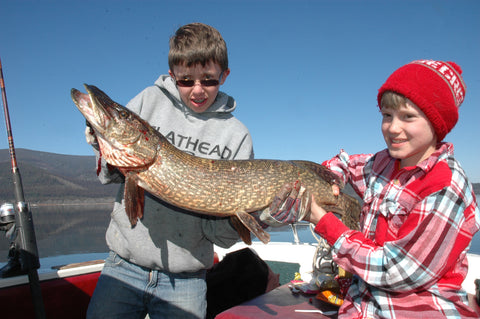Northern Pike: freshwater fighters

By Dave Reese, Montana Living
There's one species of fish in Montana that has a love/hate relationship with anglers.
Northern pike. The name alone conjures up images of slashing teeth, long slimy bodies and a head like a crocodile. Bring one of these creatures into the boat and you'd better be loaded for bear. They'll tear nets, dump tackle boxes and make a general mess of things if you're not careful. Thick gloves are recommended for prying your lure out of their mouths.
After a day of fighting these bruisers on a northwest Montana lake, a friend of mine said something I'll never forget: "Pike really don't die until they're in the frying pan." Amen to that, brother. I've had the creatures squirm after being in an iced-down cooler for two days on a camping trip. That's the hate part of the relationship.
Despite their ominous appearance and brutish fight, Northern Pike are the tastiest fish for eating. Their white, flaky meat cooks to a light delicacy with hardly any fishy taste, like a trout or salmon. I compare pike to a cod or halibut in terms of taste. That's the love part of the relationship.
While trout populations still beckon the fly angler, pike are becoming more of an attraction in parts of Montana, where you simply can't catch any other species that's as large and as accessible as Northerns. Sure, you can go after lake trout, but to go after the really big ones you need specialized downrigging equipment. For pike, a 1/16th oz. jig with rubber Mister Twister tail will do the trick. Of course, no pike in its right mind can resist a tasty offering of smelt.
Since northern pike were illegally introduced into Lake Sherburne in Glacier National Park in the early 1950s, the predator fish have become a popular fishery in Montana's rivers and lakes.
After the ice breaks on the rivers, lakes and sloughs, pike begin to spawn and become more active when the water temperature hits about 45 degrees.
When the temperature does pick up again, the pike will be found in the shallow, weedy bays of rivers, lakes and sloughs.
On the lower Flathead River, Dixon slough, Buffalo Bridge slough and Agency slough also harbor pike populations. Fishermen note: a tribal permit is needed to fish these waters, and the main Flathead below Kerr Dam is closed to motor boats until June 30.
Keys to catching pike now are putting out smelt on a treble hook (making sure you hang it horizontally), jigging with Mister Twister Tails, or pulling a spoon or spinner past the weed edges, where the pike ambush passing prey.
Red and white daredevils are popular for nailing the pike, as are small Mepps and minnow imitations.
Later in the season, around mid June, try fishing with a topwater plug, a tactic that can make for exciting action.
Despite the reputation of Esox Lucius for being a bully of the streams and lakes, trout and salmon fishermen shouldn't worry that their fisheries are in danger.
According to Montana Fish, Wildlife and Parks, pike feed mainly on forage fish and only 10 percent or less of their diet includes trout or salmon.
But, with their large mouths and razor-like teeth, the pike have become known as the bullies of the waters. They feed on anything from fish to baby ducks. Biologists even found a full-grown muskrat in a pike's stomach.



